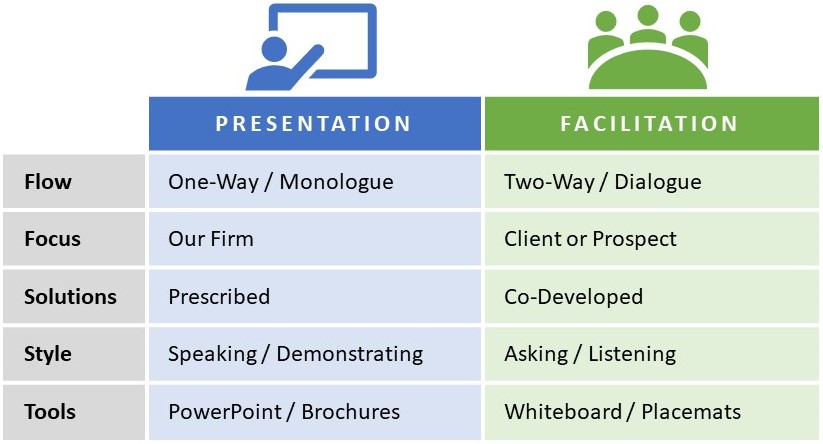Think about a time when you’ve gone through a complex decision process to make a major purchase such as a house or car. Did an agent work with you through the process, asking questions, understanding your unique needs, and making recommendations accordingly? Or were you presented loads of options (relevant or not) to sort out, and then left to draw your own conclusions? Remember how you felt throughout – Comfortable and confident that you would be guided to the right solution? Or stressed and confused, worried about making a bad decision?
Similarly, professional service advisors have a critical responsibility to help clients navigate complexity to craft solutions to their challenges. However, the style used to accomplish this varies widely, and thus has a profound impact on the client’s experience and the success of engagement outcomes. Incorporating more facilitation versus presentation in your advisory meetings can be a powerful step to building trust with clients and co-developing more effective solutions for them.
Do you tend to be more of a facilitator or a presenter? Examine your personal style across these five key attributes, and consider adjustments you can make to enhance your client advisory technique.

Flow: Presenters may prepare carefully with thoughtfully timed and well-rehearsed presentations. However, they do most of the talking and leave little room for dialogue with the client. Facilitators prepare agendas around well-crafted questions and build in time where appropriate to collaborate and work on important issues.
Focus: Presenters concentrate on articulating their own capabilities, accolades and ideas in an attempt to dazzle the client. The lens tends to be turned to the firm. Facilitators, on the other hand, turn the focus to the client. The firm’s experience and credentials are conveyed indirectly by the quality of the questions asked by the facilitator.
Solutions: Presenters tend to make assumptions of client needs based on past experience and surface exploration, often resulting in cookie-cutter recommendations. Facilitators delve into the uniqueness of each situation and are skilled at discovering the true hot buttons of the client. This can expose needs in addition to (or instead of) those originally expected.
Style: Presenters prefer speaking opportunities in which they can deliver a controlled message. This may include systematic demonstrations of products or services. Facilitators favor interactive discussions and are skilled at asking questions in a structured way that gets productive dialogue flowing.
Tools: Visual aids such as PowerPoint presentations and brochures are common tools of choice for presenters. They are materials prepared in advance and designed to support the presenter’s intended messages. Facilitators favor tools and media that support collaboration. Whiteboards, for example, can be used to create and capture concepts as they develop. Placemats can be prepared with partial information to provide a discussion framework, while also providing space for documenting key ideas.
Next Steps
Professionals striving to adopt more consultative techniques can significantly enhance their advisory skills by facilitating with clients more than just presenting to them.
If you are interested in learning more about this or other practice development strategies, please contact us to schedule a complimentary consultation, or attend an upcoming Rainmaker Growth Teams™ workshop.
Scott Moore – Executive Vice President of The Rainmaker Companies





